Cameron Bishop
All images by the artist.
Cameron Bishop: The gaze I inhabit comes packaged with a list of tickets to events that others are just locked out of. It goes without saying that this comes straight out of cultural theory 101, but if that gaze hints at the way we look at and construct the world, and we extend it to what we look from (a very particular body), much contemporary art, in which the viewer is thrown into action, assumes a privileged mobility. I for one can engage with all of your works as an able bodied, notionally, white male around six foot one with an average build and athletic capacity. In the participatory works you create you provoke the participant, offering her a variety of scenarios that require different kinds of athleticism. The bodies are compelled to slip, catch, jump, fall, pump, crash, bash, smack and whack, among other things. How do you account for the atypical body?
David Cross: I have always been interested in the idea of constraint and how, through architectural and sculptural forms, I can create a specific frame that delineates the potential for an embodied response by the audience. Eliciting a strongly physical encounter with the performative/object scenarios is a key part of this, as I ask people to employ assorted physical attributes, including balance, climbing, negotiating unstable surfaces, stamina, core strength, etc. In many ways these are athletic attributes, and may help you to negotiate the artwork, but they are not necessarily going to give you an advantage like they will in sporting contests. While sport is, to varying degrees, focused on alignment of physical and mental co-ordination, it is also about beating your opponents, running faster than them, hitting more aces and cross-court winners. I am interested in constructing scenarios that frustrate and block pure athleticism tempering physical engagement with cognitive barriers. By limiting vision, making a surface slippery, or accentuating the potential for phobias to be brought to the fore, the works neuter the performance of a pure athleticism. In a work like Pump, which requires the audience to use their foot to keep the structure inflated, too much power and strength will result in a very sore head. Likewise in Skyball, which is a sport of sorts, layers of clear vinyl and netting hamper the player’s vision. Because the works often scramble conventional hierarchies of dexterity and capacity there is, perhaps, a different focus on the atypical body. I am interested in shifting the terms around which different bodies and subjectivities are able to negotiate overtly physical phenomena.
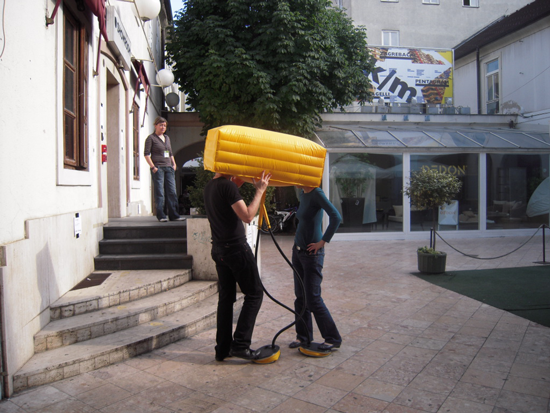
Pump, 2009, performance, inflatable PVC structure, air pumps. Image courtesy Christopher Braddock.
CB: So what we conceive of as conventional athleticism becomes bunk. In a rebuff to the spectacular culture of late capitalism, numerous artists have given themselves the brief to produce the other in the spectator. Your work straddles an intriguing line in that, at first encounter, it is striking in its color, form and occupation of space, but upon closer inspection, it invokes a phobia, or presses the participant to make a decision to move, one way or another—Hold comes to mind here. By asking the participant to latch onto an arm protruding from a wall, a phobia may be revealed, but so too a political consciousness and potential ethical dilemma? Can one trust the other?
DC: The possibility of negotiating trust within a participatory art context is certainly something I have consistently sought to get at. There are numerous projects where the audience is invited to place themselves in a space of physical or psychological precarity and trust that I or another performer will not let go of them at a great height, or damage them in some way. The vulnerability of this uncertain accord is accentuated by the partial nature of the encounter. The audience never sees my entire body but perhaps one arm, an eye or my hands. I am concealed within the inflatable structures. Judgments based on who I am and how I appear are negated, and the audience has to suspend the visual vetting process and rely on instinct and volition. In this sense, the partial nature of the encounter with the fragmented body part is deliberately uncanny, potentially leading to the activation of related phobias about loss or assorted traumas. I am especially interested in how irrational fear transforms our capacity for both decision-making and physical dexterity, making basic tasks and movements harder. The limiting of vision is key to the process. As good horror movies reveal, the limiting of vision highlights a sense of intense dread that we are somehow defenseless and thus dangerously incapacitated. I do not remove vision so much as make it contingent and provisional. For the audience in my work in most instances, it is no more useful as a source of information than touch or sound, leading to a greater equivalence between scopic and haptic modes of knowing.
While the result of this process might elicit phobic responses of one kind or another, I am at the same time profoundly curious about the possibility of an intimate encounter. How might it be possible to exchange an unguarded moment, a connection with a stranger simply through linking arms, touching their feet, holding them in space. My use of inflatable architectural forms and the assorted challenges that they pose together with the presence of my partial body, serve in part as a ruse to activate small moments of transitivity.
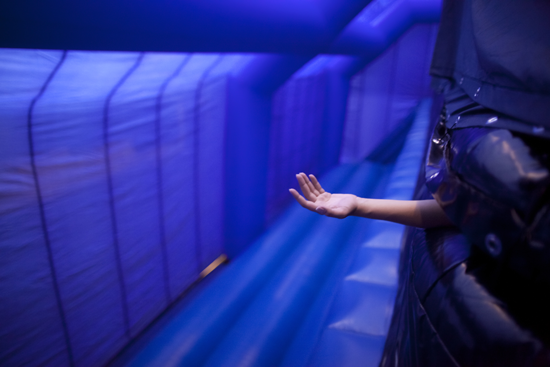
Hold, 2007, performance, inflatable structure. Image courtesy Alex Davies.
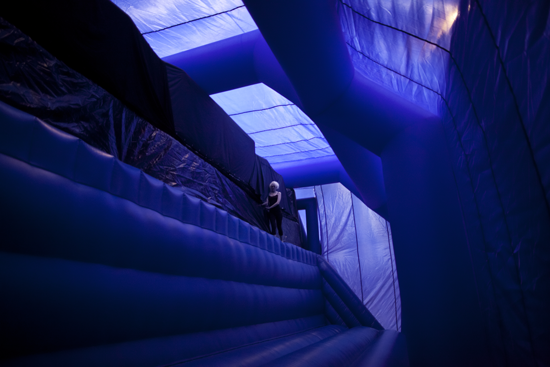
Hold, 2007, performance, inflatable structure. Image courtesy Alex Davies.
CB: Is it a key aspect of your work that you seek to activate in the audience/participant recognition of self as always partial? Is there an ambition to transform the participant through a delimitation of their athletic ability, for better or worse, outside of conventional societal or sporting rules? And in that decisive/transitive/athletic moment, is there a redemptive quality to the work because of its fleeting, as opposed to frozen, nature?
DC: Certainly in relation to the first question, I am interested in shaking out a critical reflection on the instability of subjectivity. To that extent, the idea of the partial self and partial body oscillating wildly is always there in different forms across the body of work. I find myself always trying to calibrate how, through performance and installation, it is possible to activate a heightened level of self-reflexivity in an audience member. Clearly this is never straightforward and always different for every person who engages. To varying degrees, most people are inured to self-reflection, often wary of opening their own bespoke Pandora’s box of unconscious fragilities. We all are master builders of an impressive armory of distancing devices with our own distinctive firewalls. I guess I am always looking for the blind spot, maybe even only a fleeting moment when the combination of artistic frame (inflatable quasi bouncy castle, pleasurable participatory experience, quest into an unknown space) is short-circuited by something unexpected. Returning to the uncanny, I see that as an operation that opens up the possibility of penetrating the firewall and allowing for an unguarded moment to occur. Whether you call that a liminal space or third space or whatever, for me it at least partially opens the portal and establishes the pre-conditions for disabling our distancing mechanisms. Of course, it does not always work. Some portals are barricaded shut, and the artworks may simply fail to fire on any front. But at the same time, I want to nudge or prick what Kristeva calls an awareness of our own foreignness and, in the process, coax a degree of self-reflexivity. To claim a redemptive quality in navigating the work is probably a bridge too far. Certainly in some of the works there is the pleasure of getting through, of having knocked off the ordeal and met the challenge, and this is accentuated by the element of surprise. The works mostly do not signpost what will transpire, and because of that there is a beautiful lack of preparedness for the encounter. There is no doubt some pleasure to be had in successfully navigating the unexpected and negotiating individual thresholds.

Pause, 2011, performance/installation, inflatable structure. Image courtesy MONA/Rémi Chauvin.
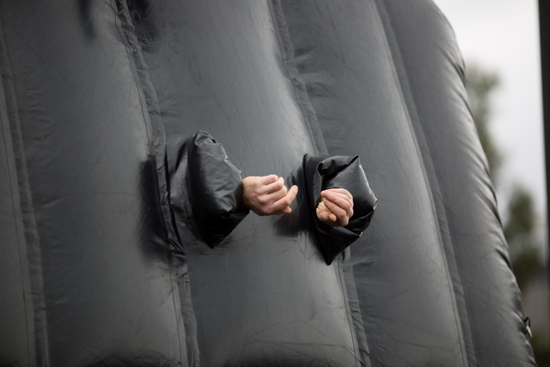
Pause, 2011, performance/installation, inflatable Structure. Image courtesy MONA/Rémi Chauvin.
CB: We live in denial of the foreigner within due to the (often feigned) dexterous self-regard we bring to our social and spatial encounters. You, as the literal foreign body in your own work, inviting the participant to pump, breath, hold, slide or catch, deny that self-assurance, not only to the viewer but also to yourself. Framed at a psychosocial level the denial of the foreigner within plays out in all kinds of ways in our treatment of those others who are seen to breach our borders, at a personal, political and national level. The work you create, in this context, may be seen as an interrogation of the western subject’s conventional experience of territories, from the body, to the museum and to the nation. As you suggest, the physical and cognitive thresholds you give to the participant invite the unguarded moment, the other side of which prompts the viewer to ponder their physical relations to others, as fragmented, fragile beings. But key to this is you, the artist, who presents as partial and foreign inside these objects. How are these objects extensions of your own body, and your own athleticism?
DC: Marina Abramovic has suggested that the future of the art experience lies in the removal of the object, leaving only an unmediated engagement between artist and audience. I think that is absurd! Such an approach not only relies on an incredibly idealized understanding of inter-personal power relations between artist and audience, but it does not take into account the complex mechanisms of distancing we have been talking about. While my utilization of the object is certainly, in part, about a fantastical extension of the body as you suggest, they are also framing mechanisms that seek to delimit an individual’s instinct to distance or protect himself or herself from an intimate encounter with another person. For me the object is a fundamental modality that significantly enhances the potential for that all elusive unguarded moment. To achieve or come close to such an affect, I need to rely on a number of devices, all of which revolve around confusion. By developing contexts that align sport and performance art or pleasurable, fun activities such as negotiating ‘bouncy castles’ with phobic architectural spaces; I seek to blur both signification and identification.
Curiously, in some ways the objects are also highly idealized extensions of my own body. They are seamless, monochromatic, shiny and smooth in a way my body most definitely isn’t. The forms are fantastical appendages that camouflage both my [own] and the participants’ alterity. They allow for a sideways encounter rather than a direct one that, while prefacing an examination of the partial, aim to speak very much to the whole of inter-personal exchange. The strength and resilience of the objects made from heavy duty, high shine PVC is also in contrast to the limitations of my body. In constantly re-staging a performative encounter over a number of hours, as in the work Pump or days in Pause, the objects remain pristine while my body slowly wears down. My capacity to perform consistently and with an iterative regularity for each audience member over time becomes a factor of athleticism as I try and match the strength and consistency of the inflatables. That I cannot sustain the required athleticism is a measure of how the objects are very much exaggerated and unattainable extensions of my body.

Level Playing Field, 2013, performance, inflatable structure. Image courtesy the artist.
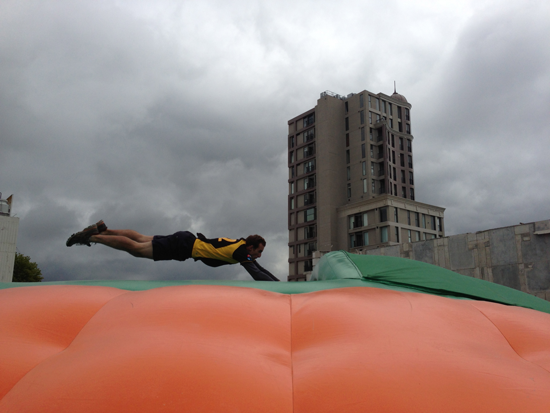
Level Playing Field, 2013, performance, inflatable structure. Image courtesy the artist.
David Cross works across performance, installation, video and photography. His practice brings together performance art and object-based environments, focusing on relationships between pleasure, the grotesque and phobia. His works often involve inflatable objects and structures that draw audiences into unexpected situations and dialogues as Cross seeks to explore contemporary experiences and understandings of participation in art. Increasingly, he has begun to work in the public sphere developing art that navigates the relationship between sport, collective decision-making and sensory deprivation. Cross has exhibited extensively in New Zealand, Australia, Eastern Europe, Canada and the United Kingdom. He has performed in international live art festivals in Poland and Croatia, and was selected as a New Zealand representative at the Prague Quadrennial in 2011. Recently, Cross has developed a major temporary public commission, Level Playing Field, for Scape Public Art 7 in Christchurch, New Zealand. Cross also writes on contemporary art, and his curatorial projects include the large art in public space projects ‘One Day Sculpture’ across New Zealand, 2008–09 (co-directed with Claire Doherty) and ‘Iteration: Again’ in Tasmania, 2011. He is Professor of Visual Arts at Deakin University. For more details, see www.davidcrossartist.com.
Cameron Bishop is an artist and academic living in Melbourne. He is currently Head of Visual Arts at Deakin University. In the last 15 years he has exhibited artwork, collaboratively and individually, in Australia and overseas. He has written a number of artist catalogue essays, book chapters and journal articles. In his art and writing he is interested in notions of identity and its connection to place. This has led to an interest in critical occupancies and the shifting role of the artist in rapidly changing cultural and technological circumstances.